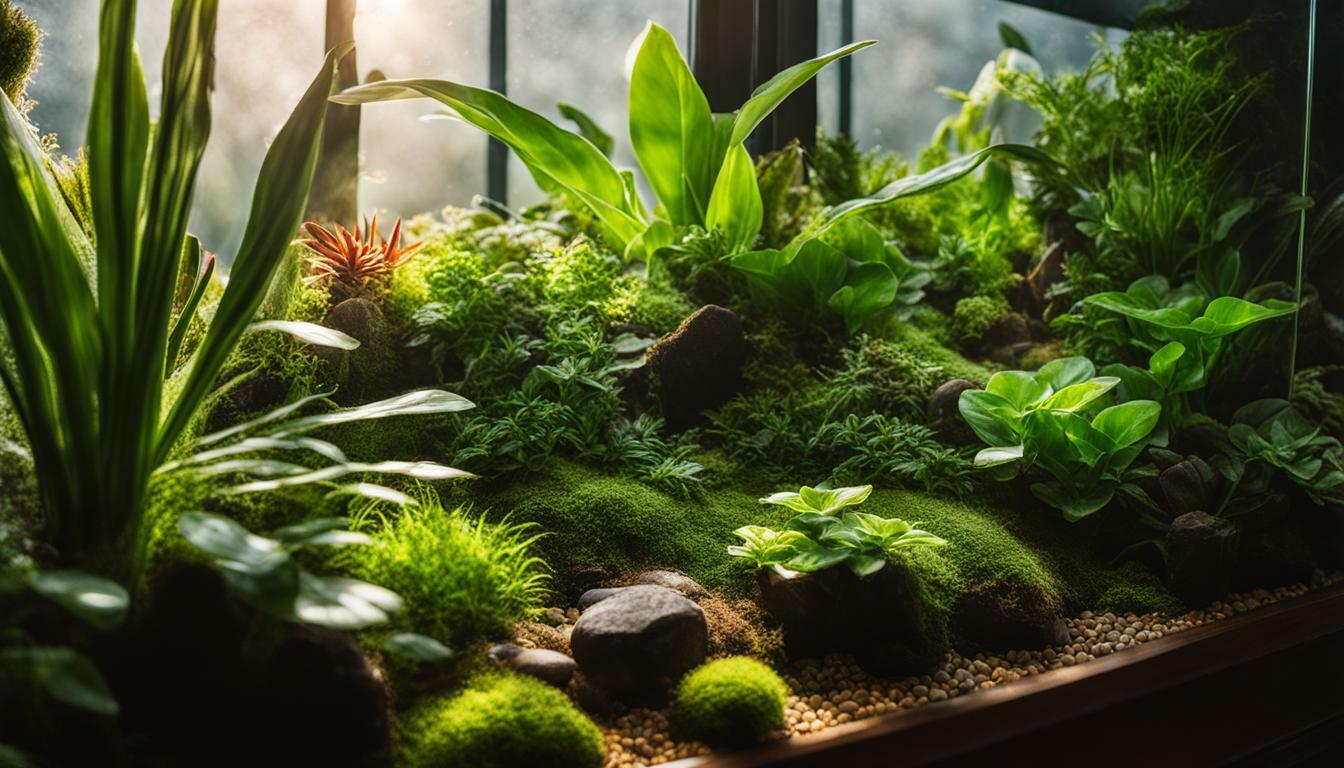Terrarium care is essential for creating a thriving miniature ecosystem that can be enjoyed for years to come. Whether you’re a beginner or an experienced terrarium owner, understanding proper care and troubleshooting techniques is crucial for maintaining a healthy environment for your plants.
In this comprehensive guide, we will explore the ins and outs of terrarium care, addressing common mistakes, troubleshooting issues, and providing tips for successful maintenance. From ensuring proper drainage and watering techniques to managing temperature and humidity levels, this guide will equip you with the knowledge to create and maintain a flourishing terrarium.
Key Takeaways:
- Understand the importance of terrarium care to create a thriving miniature ecosystem.
- Avoid common mistakes such as underwatering, overwatering, and improper lighting.
- Address issues like poor air circulation, mold growth, bacterial infections, and algal blooms.
- Maintain optimal temperature and humidity levels for terrarium health.
- Learn proper drainage and watering techniques to prevent waterlogged soil and root rot.
With these key takeaways in mind, let’s dive deeper into the world of terrarium care. By mastering these essential techniques, you’ll be well-equipped to troubleshoot any issues that may arise and create a stunning terrarium that thrives for years to come.
Terrarium Maintenance: Avoiding Common Mistakes
Maintaining a healthy terrarium requires avoiding common mistakes like underwatering, overwatering, and neglecting proper lighting. These mistakes can have detrimental effects on the delicate balance of a terrarium’s miniature ecosystem. To ensure the well-being of your terrarium, here are some essential tips for successful maintenance:
- Proper watering: It is crucial to strike the right balance when it comes to watering your terrarium. Too much water can lead to root rot and the growth of mold, while too little water can cause the plants to wither and die. Monitor the moisture level of the soil and adjust your watering schedule accordingly.
- Appropriate lighting: Just like any other plant, terrarium plants require adequate light for photosynthesis. Place your terrarium in a location where it can receive indirect sunlight or use artificial grow lights to provide the necessary light energy. Avoid placing the terrarium in direct sunlight, as this can lead to overheating and damage the plants.
- Preventing mold and rot: Excess moisture can create a favorable environment for mold and rot to thrive. Ensure proper air circulation by occasionally opening the terrarium lid to allow fresh air to flow in. Additionally, remove any dead or decaying plant matter promptly to prevent the spread of mold and potential damage to healthy plants.
- Regular cleaning: Keep your terrarium glass clean and free from dust and debris, as this can obstruct sunlight and hinder plant growth. Use a soft cloth or sponge to gently wipe the glass surfaces, taking care not to disturb the plants or disturb the arrangement within the terrarium.
By following these maintenance practices, you can create a thriving and visually appealing terrarium that will bring a touch of nature into your indoor space. Remember to observe your terrarium regularly, keeping an eye out for any signs of distress or imbalance, and take prompt action to address any issues that arise. With proper care and attention, your terrarium will flourish and provide a beautiful and tranquil environment.
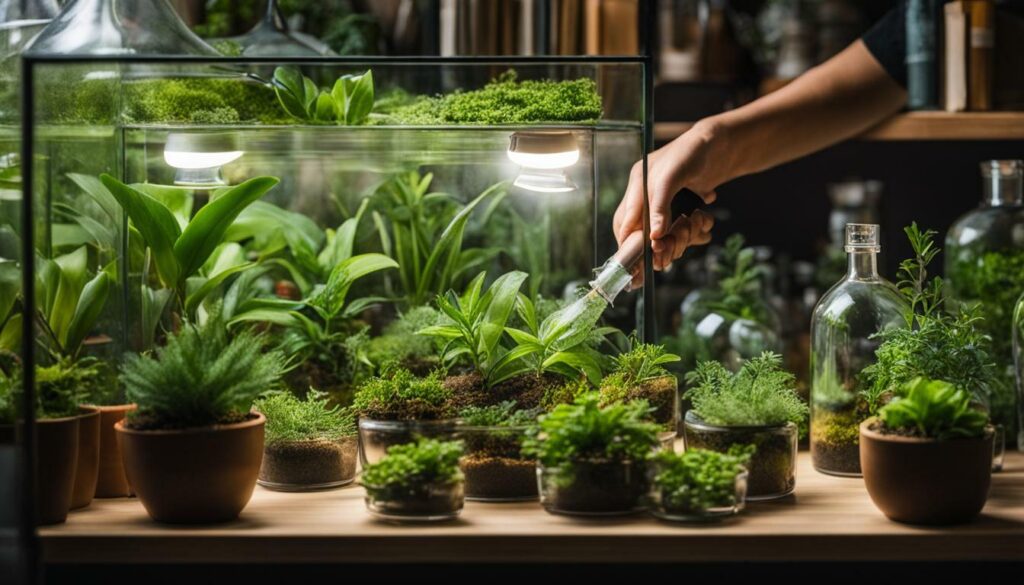
| Task | Frequency |
|---|---|
| Check soil moisture level | Weekly |
| Adjust watering schedule as needed | As necessary |
| Ensure proper lighting conditions | Daily |
| Open terrarium lid for air circulation | Weekly |
| Clean terrarium glass | Monthly |
“A well-maintained terrarium is a miniature ecosystem that brings nature’s beauty indoors.” – Terrarium enthusiast
Troubleshooting Poor Air Circulation and Mold Issues
Poor air circulation and mold growth can pose significant challenges to the health of your terrarium, but with proper troubleshooting, these issues can be mitigated. Adequate air movement is essential for maintaining a balanced ecosystem within the terrarium. Without proper ventilation, excess humidity can accumulate, leading to the growth of mold and fungus. Additionally, stagnant air can deprive plants of necessary carbon dioxide, impeding their growth and overall health.
To improve air circulation in your terrarium, consider the following tips:
- Place the terrarium in an area with sufficient airflow, away from closed spaces and corners.
- Open the terrarium cover periodically to allow fresh air to circulate. This will help regulate humidity levels and prevent the buildup of excess moisture.
- Strategically position a small fan near the terrarium to encourage air movement. Ensure the fan is set to a low speed to prevent excessive drying of the terrarium’s environment.
To address mold growth, it’s essential to identify and eliminate the factors contributing to its development. Here are some steps you can take:
- Regularly inspect the terrarium for any signs of mold or fungus. Check the soil surface, plant leaves, and glass walls for any visible growth.
- If mold is found, carefully remove affected plants and dispose of them outside of the terrarium. Ensure minimal disturbance to the remaining plants and the terrarium’s ecosystem.
- Utilize a mild vinegar solution to clean the terrarium glass and surfaces, as vinegar has antimicrobial properties that can help inhibit mold growth.
- Avoid overwatering the terrarium. Excess moisture can create a conducive environment for mold and fungus. Only water the terrarium when the soil feels slightly dry to the touch.
- Consider adding a layer of activated charcoal to the terrarium. These porous black granules can help absorb excess moisture and minimize mold growth.
By addressing poor air circulation and mold issues promptly, you can ensure the health and longevity of your terrarium. Regularly monitor the terrarium’s environment, and make necessary adjustments to maintain optimal air flow and prevent the growth of mold and fungus.
Image:
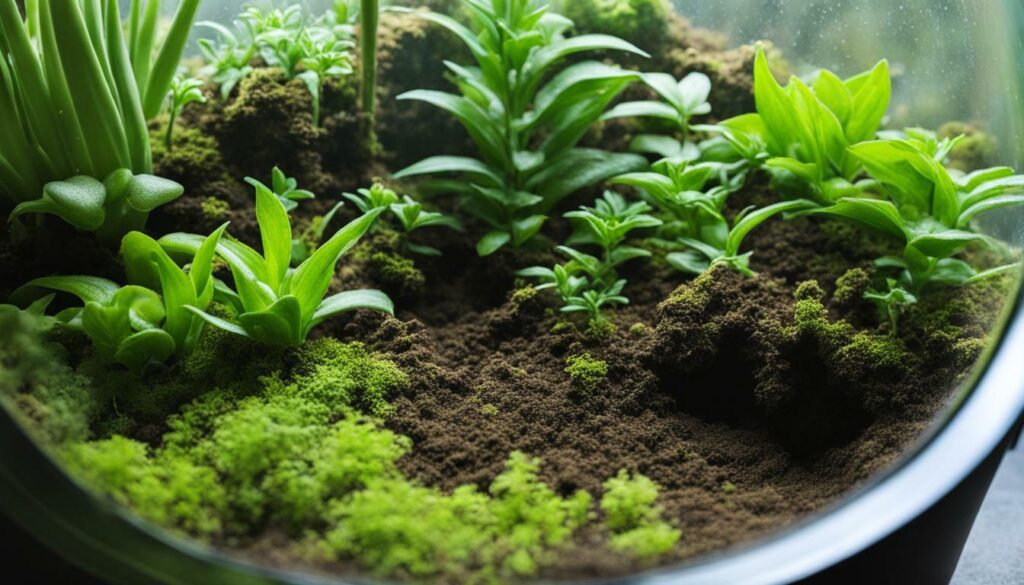
Table:
| Troubleshooting Tips | Action Steps |
|---|---|
| Improve air circulation | Place the terrarium in a well-ventilated area Open the terrarium cover periodically Position a small fan near the terrarium |
| Address mold growth | Regularly inspect the terrarium for mold Remove affected plants Clean the terrarium with a vinegar solution Avoid overwatering the terrarium Consider adding activated charcoal |
Dealing with Bacterial Infections and Algal Blooms
Bacterial infections and algal blooms can threaten the delicate balance of your terrarium, but with the right knowledge and techniques, you can effectively address these challenges. By understanding the causes and implementing preventive measures, you can maintain a healthy environment for your miniature ecosystem.
Bacterial infections in terrariums can manifest as discolored or rotting plants, foul odors, or slime-covered surfaces. To combat this issue, it is crucial to ensure proper drainage and avoid overwatering. Additionally, regularly inspecting your plants for signs of infection and promptly removing any affected foliage can prevent the spread of bacteria.
Algal blooms, on the other hand, can occur when there is an excess of light and nutrients in the terrarium. These blooms can manifest as green or brown patches on the glass or plants. To mitigate algal growth, it is essential to strike a balance between light exposure and shading. Avoid placing your terrarium in direct sunlight and position it in an area with indirect light. Furthermore, monitor the amount of fertilizer you use and be mindful not to overfeed your plants, as excessive nutrients can fuel algal growth.
To visually illustrate the impact of bacterial infections and algal blooms, refer to the image below:
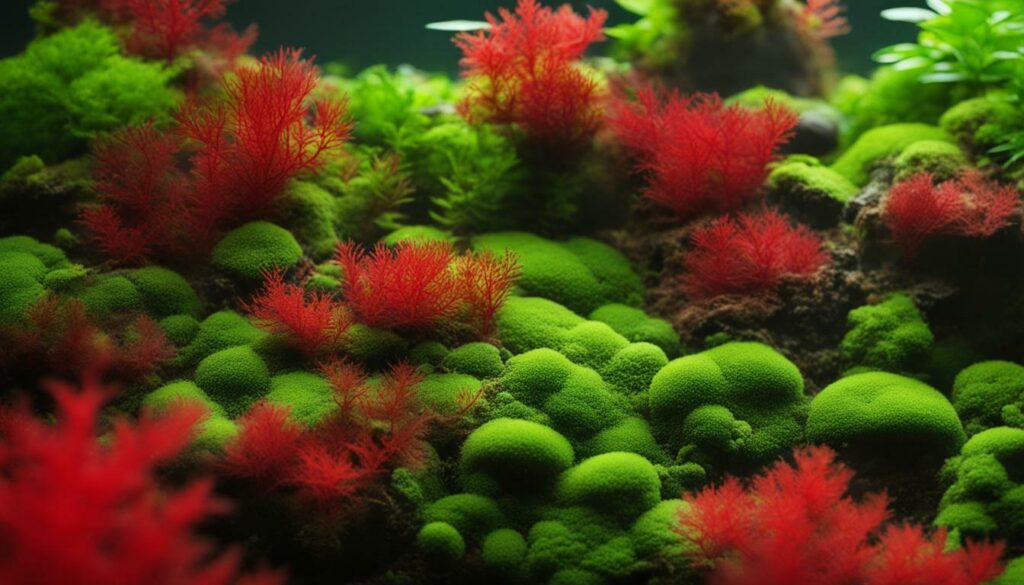
| Signs of Bacterial Infections | Preventive Measures |
|---|---|
| Foul odor | Ensure proper drainage |
| Discolored or rotting plants | Avoid overwatering |
| Slime-covered surfaces | Regularly inspect and remove affected foliage |
| Signs of Algal Blooms | Preventive Measures |
|---|---|
| Green or brown patches on glass or plants | Position terrarium away from direct sunlight |
| Excessive growth of algae | Maintain a balance of light exposure and shading |
| Overfertilization | Monitor and control nutrient levels |
By adopting these preventive measures and promptly addressing any signs of bacterial infections or algal blooms, you can maintain the health and vitality of your terrarium.
Managing Temperature and Humidity Levels
Proper temperature and humidity management are key to creating a favorable environment for your terrarium’s plants, preventing issues like overheating and excess humidity. The temperature within a terrarium should mimic the natural conditions that the plants would experience in their native habitats. It is essential to maintain a consistent temperature range to ensure the well-being of the plants.
To regulate the temperature in your terrarium, consider the following tips:
- Place the terrarium in an area away from direct sunlight to prevent overheating.
- Monitor the temperature regularly using a thermometer and adjust as needed.
- Use a terrarium heater or cooler if necessary to maintain the ideal temperature range.
Humidity levels are equally important for the health of your terrarium. Most tropical plants thrive in high humidity environments, but it’s crucial to strike the right balance to prevent excess moisture buildup. Here’s how you can manage humidity effectively:
- Monitor the humidity levels using a hygrometer to ensure they stay within the optimal range for your plants.
- If the humidity is too low, mist the terrarium with water or use a humidity tray to increase moisture levels.
- If the humidity is too high, provide adequate ventilation by partially opening the terrarium lid or using a small fan to promote air circulation.
Remember, different plants have varying humidity requirements, so it’s important to research the specific needs of the plants in your terrarium. By masterfully managing temperature and humidity levels, you’ll create a thriving environment for your terrarium plants.
“Proper temperature and humidity management are essential for maintaining a healthy terrarium environment.”
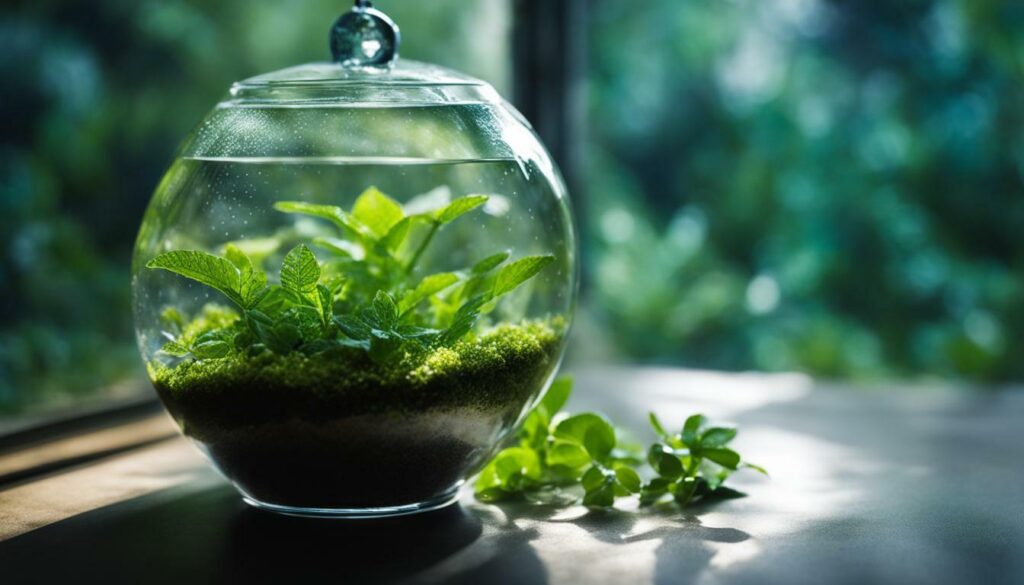
| Plant | Ideal Temperature Range (°F) | Ideal Humidity Range (%) |
|---|---|---|
| Ferns | 65-75 | 50-70 |
| Succulents | 70-85 | 30-50 |
| Orchids | 65-80 | 50-70 |
Ensuring Proper Drainage and Watering Techniques
Maintaining proper drainage and mastering watering techniques are vital to prevent issues like waterlogging and root rot in your terrarium. Terrariums are delicate ecosystems, and the right balance of moisture is crucial for the overall health of the plants inside.
To ensure proper drainage, start by layering the bottom of your terrarium with a few centimeters of coarse gravel or pebbles. This will create a space for excess water to collect, allowing the roots to avoid prolonged exposure to standing water. On top of the gravel, add a layer of activated charcoal to prevent any potential odors or harmful substances from building up over time.
When it comes to watering, remember that less is often more. It’s important to avoid overwatering, as this can lead to suffocating the roots and promoting the growth of mold and fungus. Instead, use a spray bottle or a small watering can with a narrow spout to target the soil directly. Aim to keep the soil slightly damp but not soggy, and always err on the side of underwatering rather than overwatering.
| Signs of Overwatering | Signs of Underwatering |
|---|---|
| Mold or fungus growth | Dry, shriveled leaves |
| Yellowing or wilting foliage | Soil pulling away from the edges of the container |
| Root rot or a foul smell | Stunted growth |
Remember to monitor the moisture levels in your terrarium regularly and adjust your watering routine accordingly. Factors such as humidity levels, temperature, and the types of plants in your terrarium will also influence their watering needs. By mastering proper drainage and watering techniques, you’ll create an environment where your terrarium plants can thrive.
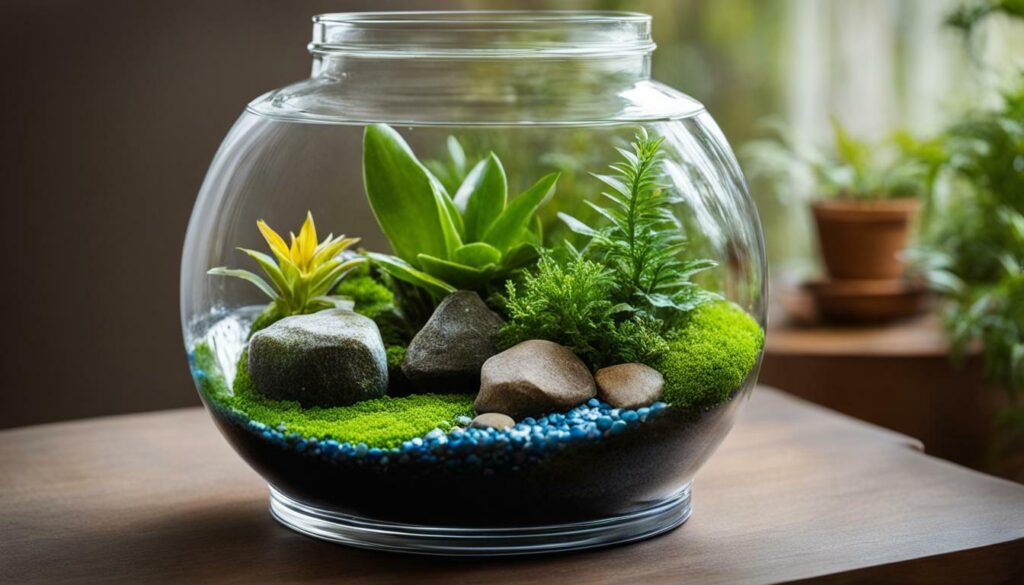
Choosing the right plants is crucial for creating a harmonious terrarium ecosystem that thrives in its unique conditions. The plants you select will play a vital role in the overall health and aesthetics of your miniature garden. When choosing plants for your terrarium, it is important to consider factors such as light requirements, humidity tolerance, and growth habits.
- Light Requirements: Some plants thrive in bright, indirect light, while others prefer lower light conditions. Pay attention to the light requirements specified for each plant and select varieties that are suitable for the level of light available in your terrarium.
- Humidity Tolerance: Different plants have varying levels of tolerance for humidity. Some plants, such as ferns and mosses, thrive in high humidity environments, while others prefer drier conditions. Consider the natural habitat and humidity preferences of each plant before adding it to your terrarium.
- Growth Habits: It is important to choose plants that will not outgrow the space within your terrarium. Look for compact or slow-growing varieties that will maintain a manageable size. Trimming overgrown plants is essential for preventing overcrowding and maintaining a visually appealing terrarium.
Some popular plant choices for terrariums include ferns, mosses, fittonias, and succulents. These plants are known for their ability to thrive in the enclosed environment of a terrarium and complement each other well. However, it is important to research individual plant requirements and ensure they are compatible with each other to create a balanced ecosystem.
Remember, each terrarium is unique, and different plants may require different care. Take the time to understand the specific needs of the plants you choose and make adjustments as necessary. By selecting the right plants for your terrarium, you can enjoy a beautiful and flourishing miniature garden.
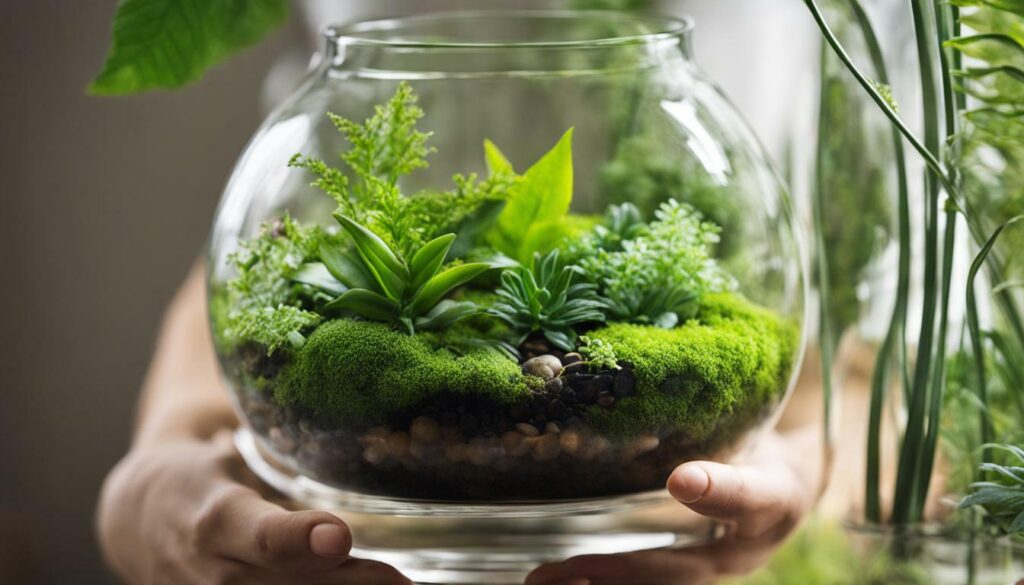
| Plant Name | Light Requirements | Humidity Tolerance |
|---|---|---|
| Fern | Indirect light to low light | High humidity |
| Moss | Low light | High humidity |
| Fittonia | Bright, indirect light | Medium to high humidity |
| Succulents | Bright, direct light | Low humidity |
What Are the Most Common Plant Issues in Terrariums and How Can They Be Addressed?
When it comes to troubleshooting terrarium plant care, the most common issues include overwatering, lack of sunlight, and pest infestations. To address these issues, make sure to only water the plants when the soil is dry, place the terrarium in a well-lit area, and regularly check for any signs of pests and treat them accordingly.
Pruning and Cleaning for Terrarium Health
Regular pruning and cleaning are essential to maintain the health and aesthetics of your terrarium, ensuring the optimal growth of its inhabitants. Proper maintenance practices not only keep your terrarium looking beautiful but also prevent the growth of harmful bacteria, fungi, and pests.
When it comes to pruning, it is important to remove any dead or overgrown foliage to maintain the balance within your terrarium. Overgrown plants can overshadow smaller ones, preventing them from receiving adequate light and stunting their growth. Use sharp, clean pruning shears to carefully trim back any excess foliage, promoting healthy growth and maintaining an attractive terrarium landscape.
Cleaning your terrarium is another crucial aspect of its care. Dust and debris can accumulate on the glass, reducing the amount of light that reaches the plants inside. Use a soft, lint-free cloth and a mixture of mild soap and water to gently wipe down the interior and exterior surfaces of the terrarium. Pay attention to corners and crevices where dirt may be trapped. Regular cleaning will not only enhance the visual appeal of your terrarium but also support the overall health of the ecosystem.
| Pruning Tips: | Cleaning Tips: |
|---|---|
| Trim dead or overgrown foliage | Gently wipe down the glass with a soft cloth |
| Remove plants that are blocking light | Use mild soap and water mixture for deeper cleaning |
| Regularly check for pests or diseases | Pay attention to corners and crevices |
“Pruning and cleaning are essential for the longevity and vitality of your terrarium. By maintaining proper pruning techniques and regular cleaning, you can enjoy a thriving ecosystem that will bring joy and beauty to your space.”
Remember, each terrarium is unique, and its care requirements may vary. Regularly observing your terrarium will help you identify specific pruning and cleaning needs. By staying proactive in maintaining your terrarium’s health, you can create a beautiful and harmonious miniature world for you and your plants to enjoy.
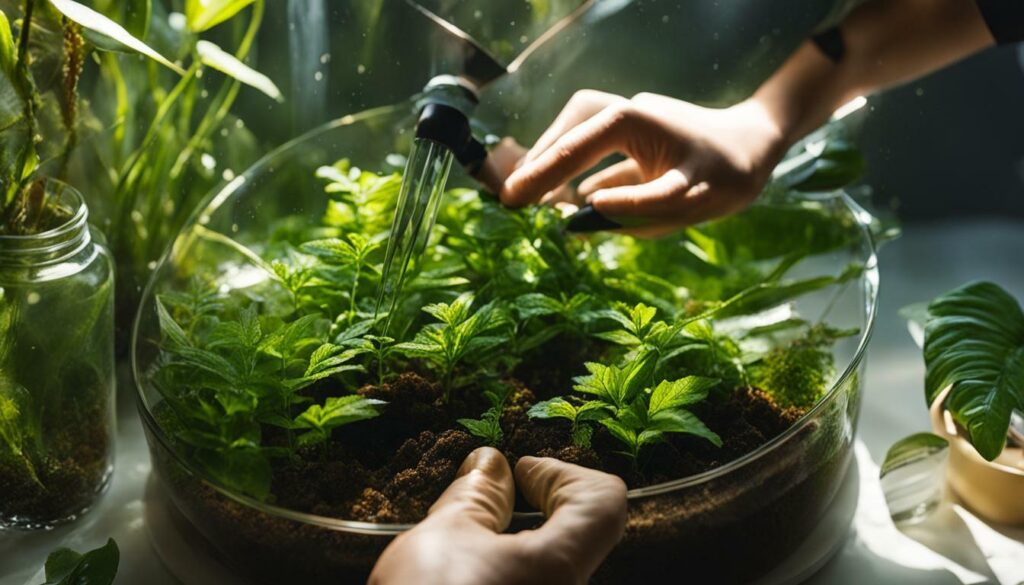
By mastering terrarium care and troubleshooting, you can create a beautiful miniature ecosystem that brings joy and relaxation to your space. Terrariums require proper maintenance and attention to ensure the health and vitality of the plants within. Avoid common mistakes such as underwatering or overwatering, as well as providing the right amount of light for optimal growth.
Watching out for mold and rotting plants is crucial, as these issues can quickly spread and harm the entire terrarium. Regular pruning and cleaning will help maintain the proper size of the plants and keep the terrarium free from debris. Keeping the terrarium glass clean will allow for clear viewing and optimal light penetration.
When troubleshooting, consider addressing poor air circulation and mold issues promptly as they can lead to plant stress and even death. Take proactive measures against bacterial infections and algal blooms, as these can quickly damage the delicate balance of the terrarium environment. Managing temperature and humidity levels is vital for the overall health of the terrarium. Overheating and excess humidity can cause stress to the plants and may encourage the growth of harmful fungi and bacteria.
Additionally, proper drainage and watering techniques are essential to prevent waterlogged soil and root rot. Choosing the right plants for your terrarium is crucial for their successful growth. Consider factors such as light requirements, tolerance to humidity, and growth habits when selecting plants. Each plant should complement the others in the terrarium, creating a cohesive and balanced ecosystem.
By following these guidelines and staying vigilant in your terrarium care and troubleshooting efforts, you can enjoy the beauty and benefits of a thriving miniature ecosystem in your space.
FAQ
What are the common mistakes to avoid in terrarium care?
Common mistakes in terrarium care include underwatering, overwatering, improper lighting, mold and rotting plants, and neglecting to clean the terrarium glass regularly.
How can I improve air circulation and prevent mold in my terrarium?
To improve air circulation, ensure that the terrarium has proper ventilation. You can also open the lid periodically to allow fresh air in. To prevent mold, avoid overwatering and make sure the terrarium is not excessively humid. You can also remove any decaying plant material promptly.
How do I deal with bacterial infections and algal blooms in my terrarium?
Bacterial infections can be treated by removing infected plants and ensuring good ventilation. Algal blooms can be controlled by reducing excess light and avoiding overwatering. Keeping the terrarium clean and maintaining optimal conditions can help prevent both issues.
What should I do if my terrarium overheats or has excess humidity?
To address overheating, move the terrarium to a cooler location or provide shade. To manage excess humidity, ensure proper air circulation and consider using a dehumidifier or adding more ventilation. Monitoring temperature and humidity levels is crucial for maintaining a healthy terrarium.
How can I ensure proper drainage and watering techniques in my terrarium?
To ensure proper drainage, use a well-draining soil mixture and layer the bottom of the terrarium with gravel or activated charcoal. Water sparingly, allowing the soil to dry out slightly between waterings. Avoid overwatering, as this can lead to waterlogged soil and root rot.
What are some factors to consider when choosing plants for my terrarium?
When choosing plants for your terrarium, consider their light requirements, humidity tolerance, and growth habits. Opt for plants that will thrive in the conditions of your terrarium and complement each other in terms of size and appearance.
How important is pruning and cleaning for terrarium health?
Regular pruning helps maintain the size and shape of the plants in your terrarium and promotes healthy growth. Cleaning the terrarium, removing dead foliage, and keeping it free from debris prevents the growth of harmful bacteria and maintains a visually appealing environment.

